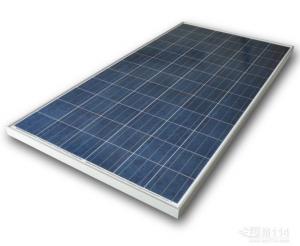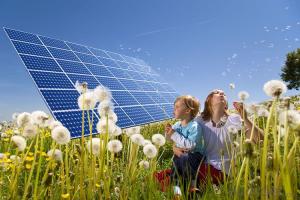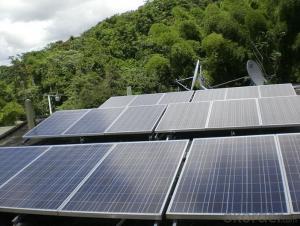Pigeon Proofing Poly Solar Panels-240w-High Quality and Good Price
- Loading Port:
- Shanghai
- Payment Terms:
- TT OR LC
- Min Order Qty:
- 1000 watt
- Supply Capability:
- 500000 watt/month
OKorder Service Pledge
OKorder Financial Service
You Might Also Like
Product Description:
Solar Polycrystalline Series Panels
Introduction of Polycrystalline Solar Panels
CNBM Solar photovoltaic (PV) Panel is designed for large electrical power requirements. It is the optimal choice for both on-grid and off-grid power systems. CNBM Solar panel offers high performance of power per square foot of solar array. Polycrystalline silicon(c-Si): often made using the Czochralski process. Single-crystal wafer cells tend to be expensive, and because they are cut from cylindrical ingots, do not completely cover a square solar cell module without a substantial waste of refined silicon. Hence most c-Si panels have uncovered gaps at the four corners of the cells.
Characteristics of Polycrystalline Solar Panels
I Solar Cell : High efficiency crystalline solar cell. Even if under the weak light, the solar module can produce maximum power output.
II Tempered glass (toughened glass): Anti-reflecting coating and high transmission rate glass increase the power output and mechanical strength of solar module.
III EVA and TPT: Using high quality EVA and TPT to prevent destroying and water.
IV AI frame: Without screw, corner connection. 6 holes on the frame can be installed easily.
V Junction box: Multi function junction box with water proof.
VI Long lifetime: ≥25 years; Less power decrease
VII Good performance of preventing from atrocious weather such as wind and hails.
VIII Resisting moisture and etching effectively, not effected by geology.
Standard Test Conditions of Polycrystalline Solar Panels
The opto-electrical specifications shown below are stabilized values being measured at Standard Test Conditions, Irradiance: 1000W/m2, Spectrum: AM1.5 at 25°C, The info below is subject to manufacturing tolerances. Where appropriate minutes of measurement are available and are used for the dimensioning of the installation.
Advantages of Polycrystalline Solar Panels
• CNBM Solar performance guarantees for 25 years
• 12 years guarantee for workmanship
• Timeliness of delivery
CNBM International Corporation's products including Polycrystalline Solar Panel, Polycrystalline Solar Panel have received and enjoyed famous reputation in many countries and regions in the world .As a solar panel supplier in China, we strive to provide our customers with excellent service, superior products and unmatched value.
Characteristics of Polycrystalline Solar Panels
Max Power Voltage Vmp (V) | 30.8V | 31.1V |
Max Power Current Imp (A) | 7.8A | 7.89A |
Open Circuit Voltage Voc (V) | 37.4V | 37.4V |
Short Circuit Current Isc (A) | 8.55A | 8.65A |
Max Power Pm (W) | 240W | 245W |
Temperature Coefficient of Cells
NOCT | 47℃±2℃ |
Temperature Coefficients of Isc (%/℃) | 0.064 |
Temperature Coefficients of Voc (%/℃) | -0.33 |
Temperature Coefficients of Pmp (%/℃) | -0.45 |
Mechanical Data Solar Polycrystalline Series
Power | 240W/245W |
Dimension | 1655×992×40mm |
Weight | 22.5kg |
Tolerance | ±3% |
The dimension of the modules can be changed according to the demand of clients Limits.
Operating Temperature | –40 °C to +85°C |
Storage Temperature | –40 °C to +85°C |
Max System Voltage | 700V |
Guarantee Solar Polycrystalline Series Panels
Products Guarantee | 10 yrs free from defects in materials and workmanship |
Performance Guarantee | No less than 90% within 10yrs and no less than 80% within 25yrs |
Certificates | IEC, ISO, TUV, CE |
Package of Solar Polycrystalline Series Panels




FAQ
We have organized several common questions for our clients,may help you sincerely:
1. What’s price per watt?
A: It’s depends on the quantity, delivery date and payment terms of the order. We can talk further about the detail price issue. Our products is high quality with lower price level.
2. Can you tell me the parameter of your solar panels?
We have different series of cells with different power output, both from c-si to a-si. Please take our specification sheet for your reference.
3. How do you pack your products?
We have rich experience on how to pack the panels to make sure the safety on shipment when it arrives at the destination.
- Q: Can solar panels be used for powering a research facility or laboratory?
- Yes, solar panels can be used to power a research facility or laboratory. Solar panels convert sunlight into electricity, providing a sustainable and renewable source of power. By harnessing solar energy, research facilities and laboratories can reduce their reliance on traditional energy sources and contribute to a greener and more environmentally friendly operation. Additionally, solar panels can be integrated into the existing infrastructure of the facility, making them a viable option for powering various scientific equipment and systems.
- Q: Can anyone give me a link to a website that sells really big solar panels? Enough to run a small cafe on entirely solar power.
- I think you may be surprised how much energy a little cafe like that uses. Since the air conditioning, refrigerators, and other appliances are going nonstop, I'd expect the energy usage to be several times that of a normal house. If you have access to the electric bills of the cafe while it was in operation, look up the kWh's used per month. For scale, I will say that our house uses 500 kWh per month, and needs 3 kW of panels to keep up with that. Scale up to match the restaurant, as a ballpark estimate. If you don't have access to the electric bills, then go visit a similar cafe in town, or a nearby town, and ask them how much their electric bill is. If the ballpark estimate still looks doable to you, then contact a professional solar installer to get an accurate, no-obligation estimate. Most likely, the cafe will use gas heat for cooking. But if not, electricity from solar panels is probably the most inefficient way to cook. Consider having solar ovens for most of the cooking, if you have land, with gas as a backup on cloudy days.
- Q: If I wanted to add solar panels to my home to produce on average, 8 kWh of electricity daily, how much do you estimate it would cost using state of the art technology?I live in Virginia (Washington DC Metro Area), and I have Dominion Power. I pay the following electric rates:Jun-Sep $0.0904/kWhOct-May $0.0776/kWhAnnual Ave: $0.0824/kWhDistribution charges add on approximately another $0.0228/kWh.How long would the ROI for an 8 kWh/day solar system be?
- Figure 8 hours of sun per day, so 8 kW-hr is a rate of kW, which is a medium sized panel, probably not enough to operate your house totally, unless you have a very small unit. Averaged over 24 hours, that is power at a rate of only 300 watts, enough for a TV. Average US home use is .2 kW, which over 24 hours is 29 kW-hr, plus you need extra for cloudy days, peak demands, and to charge batteries. You have to decide off-grid or on-grid, and if you want to (and are allowed to) sell excess power to the power company. Off gird, the cost of batteries and charge controller are a large part of the cost. On-grid, you have to purchase equipment approved by the power company to match your power with the grid. Panels will cost about $3 per watt, so for 000 watts that is $3000. Double that for installation, then add in cost of charge controller, inverter, batteries, etc. The last items depend on your alternatives, see paragraph above. .
- Q: Can solar panels be damaged by birds or rodents?
- Yes, solar panels can be damaged by birds and rodents. Birds may nest, perch, or peck at the panels, causing cracks or scratches on the surface. Rodents, on the other hand, can chew through the wiring or insulation, leading to electrical issues. Regular maintenance and bird deterrents can help minimize the risk of damage.
- Q: ok so when a solar panel is marked as a certain wattage dose that mean it makes that much in a day in an hour or constant, dose it still work at night or what ? is it worth it or is it more of a pain? can some one tell me what all the watts and volts mean ?? and can some one tell me what a kilowhat is in refrence to some thing i understand like howmany loads of laundey can you do wt a watt? i need help understanding this stuff?
- Quick okorder .
- Q: This is for my science project and i cannot figure it outWe assumed that blue light shining on a solar panel would give off the higher volt reading because it has the shortest wavelength and the highest energy, but it was actually the lowest. Why does this happen? Im very confused And cant find the answer anywhere.... ,thank you!!
- It is based on what the solar panel is made out of. Many of them will generate electric into the NIR region.
- Q: Is this a good kit for building a solar panel?
- Only okorder /
- Q: I have a question about solar panels. What are the benefits of this system if I installed in my home. for example i know it produces electricity but does it do anything else? How many panel would you guys think I would need for 2000 sq ft. do you know if it produces hot water? Thanks for your help
- 30 years ago when the Hippies shut down our clean Nuclear plants They promised a clean miracle. No such thing! I'm sad to say at best Solar will only provide a fraction of our energy needs. (I guess if one abuses enough drugs they'll think up anything?) I am an apprentice for a Electric foreman; we calculate $50,000.00 in panels will meet the needs of a k foot house. So you would need a hundred grand. You'd save 00 dollers a month in electricity, but you'd be paying ,000 a month to pay off your loan of 00,000.00 in panels. God Bless You indeed a nice thought if it was practical.
- Q: Can solar panels be installed on satellites?
- Yes, solar panels can be and are often installed on satellites to generate electricity from sunlight for powering the satellite's various systems and instruments.
- Q: How many solar panels do you need on your house to power your heater in winter?
- Your house, and probably your yard wouldn't be big enough to hold them. I did this exercise once (not doing it again) for someone who wanted to replace his 6hp outboard motor with a solar powered one. The calculations ended up that he would need something like .5 acres of solar panels to get that much energy. Not happening. That said, an passive solar home, can get a significant amount of warmth from the sun directly. But it doesn't work very well at night, when it's coldest. (wonder why that is... probably a climate scientist could help us with that? -- oh, wait. They say warming doesn't have anything to do with the sun.) Edit. I didn't use theoretical stuff to come up with my numbers, I used the claims of actual off-the-shelf solar panels sold by West Marine, calculated the power, and did the math based on existing panels.
Send your message to us
Pigeon Proofing Poly Solar Panels-240w-High Quality and Good Price
- Loading Port:
- Shanghai
- Payment Terms:
- TT OR LC
- Min Order Qty:
- 1000 watt
- Supply Capability:
- 500000 watt/month
OKorder Service Pledge
OKorder Financial Service
Similar products
Hot products
Hot Searches
Related keywords




























